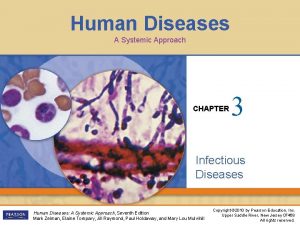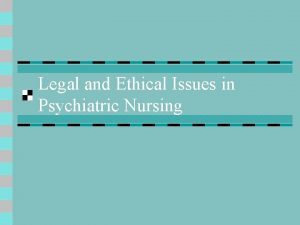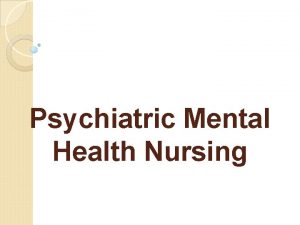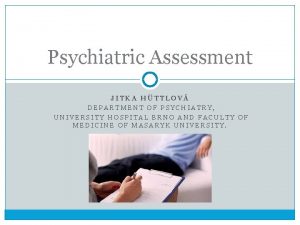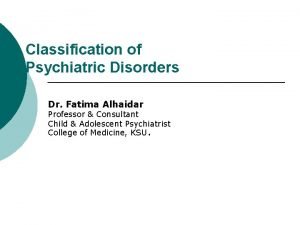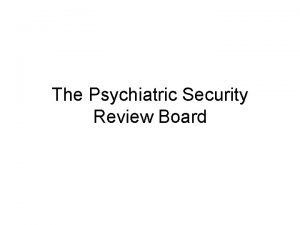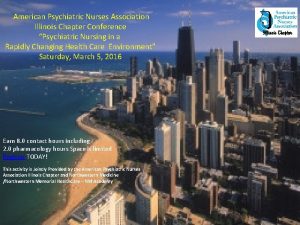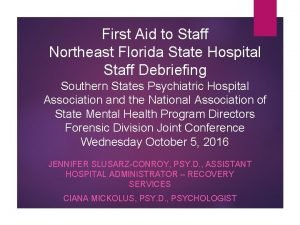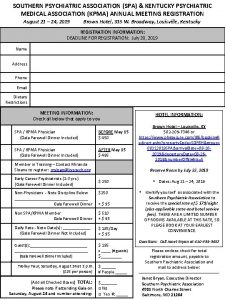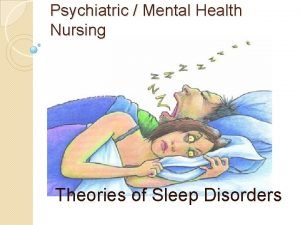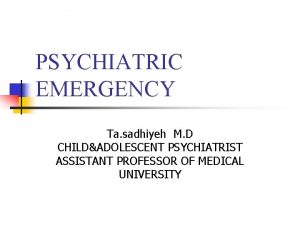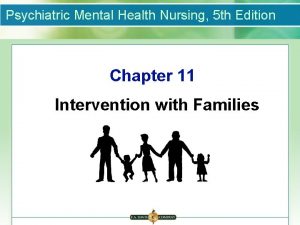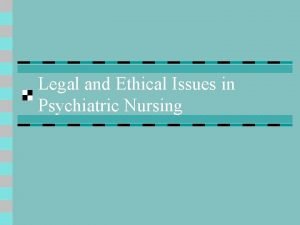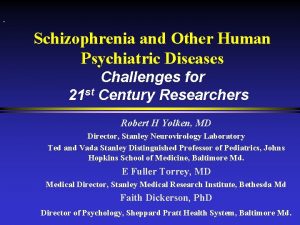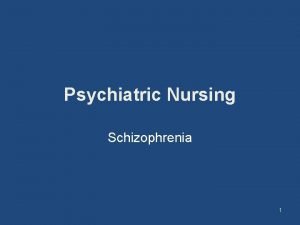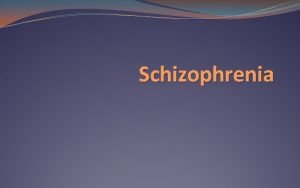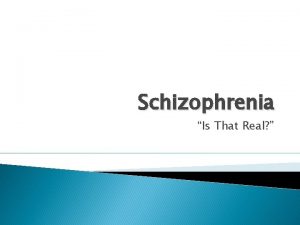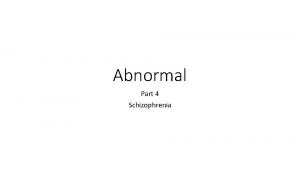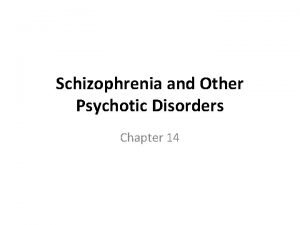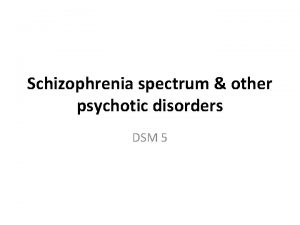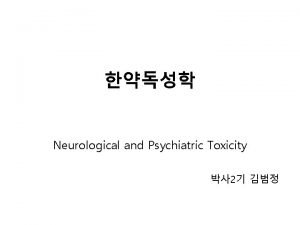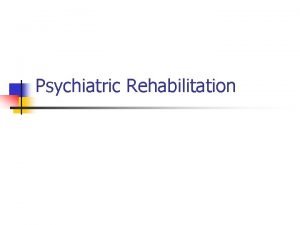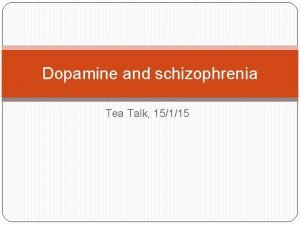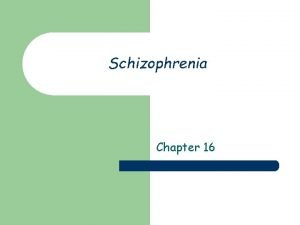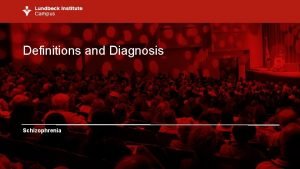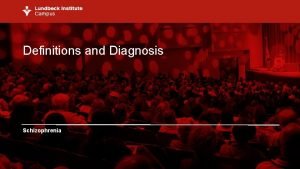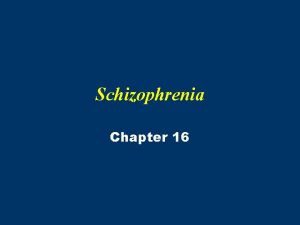Schizophrenia and Other Human Psychiatric Diseases Challenges for
































- Slides: 32

Schizophrenia and Other Human Psychiatric Diseases Challenges for 21 st Century Researchers Robert H Yolken, MD Director, Stanley Neurovirology Laboratory Ted and Vada Stanley Distinguished Professor of Pediatrics, Johns Hopkins School of Medicine, Baltimore Md. E Fuller Torrey, MD Medical Director, Stanley Medical Research Institute, Bethesda Md Faith Dickerson, Ph. D Director of Psychology, Sheppard Pratt Health System, Baltimore Md.

Schizophrenia Clinical and Epidemiological Features § Positive Symptoms § Hallucinations, Delusions, Disordered Thinking § Negative Symptoms § Withdrawal, Amotivation, Restricted Expressiveness § Impairment in Cognitive and Social Functioning § Structural and Functional Brain Abnormalities § Lifetime prevalence approximately 1% § Peak onset of Symptoms in Young Adulthood § Massive societal Consequences Worldwide § Currently Available Medications § Symptomatic improvement § High rate of side effects § Do not affect overall disease process

Genetics Of Schizophrenia • Increased Incidence in Biological First Degree Relatives • General Population 1% • First Degree Relatives 7 -9% • Monozygotic Twins 30% • Most individuals with schizophrenia do not have a first • • degree relative with this disease. Genetic factors have a large relative risk but a small risk in the overall population (5%) Intensive search for genes using molecular methods • Multiple (>30) chromosomal regions of linkage • Genetic polymorphisms of minor effect (OR~2) • No genes of major effect in different populations

Microbial Agents and Schizophrenia Epidemiological Findings § Specific Infectious Agent § Perinatal Rubella (Brown et al, 2001; OR~3. 5) § Neonatal Enterovirus (Jones et al, 1998 OR~4) § Maternal Herpesvirus (Buka 2001; OR~4) § Possible Infectious Exposure § Seasonality of Birth (Torrey at al, 1998; OR~2) § Urban Birth (Mortenson et at, 1999, OR~2. 5) § Exposures in Pregnancy (Brown et al, 2000; Torrey et al, OR~3) § Case Reports § HIV § Herpes Simplex Virus § Borrelia bergdorferii

Human Infectious Diseases Known Genetic Associations Agent Gene HIV EBV Hepatitis B Mycobacteria Salmonella H pylori S mansoni L donovani CCR 5 XLP Man BP Il 12; IFN R HLA-DQ GMCSF Cytokines P falciparum Hg. S, G 6 PD Function Co-Receptor T-Cell Activity Viral binding Phagocytosis Immune Response Phagocytosis Immune Function Oxygenation

Psychiatric Disorders Association with Viral Encephalitis Caroff et al, Psych Ann 31: 193, 2001

Infections and Psychosis Bacteria and Parasites q Bacteria q Streptococcus pyogenes q Borrelia burgdorferi q Treponema pallidum q Ehrlichiae q Mycoplasma pneumoniae q Bartonella henselae q Salmonella typhii q Parasites q Toxoplasma gondii q Plasmodium falciparum q Babesiae q Taenia solium q Leishmania donovani

Antecedents of Schizophrenia 264 Cases/528 Controls Fever in Pregnancy Complications Delivery Complications Urban Birth Developmental Delay Family Cat Family Dog 1 Scz Research 46: 17 -23, 2000 2 3 Odds Ratio (95% Conf) 4

Schizophrenia Working Hypotheses Most cases of schizophrenia are the result of infections and other environmental insults occurring in genetically susceptible individuals before the onset of clinically apparent symptoms. q Distinct gene-environmental interactions may be operant in different populations. q The role of specific infectious agents can be defined by clinical trials of anti-microbial chemotherapy. q

Identification of Infections in Schizophrenia Methods-Old and New l Analytic Methods n n n l Differential Display PCR Library screening Microarrays Two-dimensional electrophoresis Enzyme immunoassays Samples for Analysis Brains collected by the Stanley Neuropathology Consortium n Cerebrospinal fluid and blood samples from individuals with recent onset schizophrenia n Blood samples from mothers of infants who developed schizophrenia in adult life n

Differential Display PCR Brain from Individual with Schizophrenia (S) and Unaffected Control(U) M S U S U M

HIV Human Endogenous Retrovirus HERV-W

Endogenous Retroviruses Borderland Between Viruses and Genes II q Dynamic Effects on Gene Function Promoter control of adjacent genes- PLA 2; Placental Genes q Functionality of viral proteins-Syncytin; ASCT 1 Glutamate transporter q q q Interaction with infectious agents- Herpesviruses; Toxoplasma q Interaction with soluble mediators-Hormones; Cytokines Role in Human Disease Diabetes- Superantigen activation q Multiple Sclerosis- Glial cell function q Autoimmune Arthritis- T cell activity q

Endogenous Retroviruses Activation and Transcription Microbe DNA Hormone Mediator 5’LTR Viral Proteins 3’LTR

Human Retroviruses Activation by Herpesviruses Retrovirus Herpesvirus Reverse Transcriptase Activity

Ctr DNA Scz Endogenous Retroviral PCR CSFs: Schizophrenia and Controls Herv-W HERVw C 1 A 2 A 3 A 4 A 5 A 6 GTTCAGGGATAGCCCCCATCTATTTGGCCAGGCATTAGCCCAAGACTTGAGTCAATTCTCATACCTGGACACTCTTGTCCTTCAG --------------------------C-------------------------------A---------------------------------------------------TG----------------------------------C--------C--G--------------G------A--------------T-----C--G--------------TG-----A---------------------------------------------T------CA---TA----------C--G--------------TG-

Reactivity to Retroviruses Schizophrenia and Controls

Collaborative Perinatal Study Design § § § 65, 000 healthy mothers enrolled from 1957 -1964 from 11 geographically diverse sites. Mothers followed closely during pregnancy. Neurocognitive and developmental testing during first 7 years of life. Primary outcomes cerebral palsy and mental retardation. Serum samples obtained from mothers during pregnancy and infants at birth (cord). Offspring identified with psychiatric diseases in 1990’s and matched to maternal and cord blood serum specimens.

Schizophrenia in Adult Life Inflammation During Fetal Development

Schizophrenia in Adult Life Infection During Fetal Development 6. 00 Odds Ratio 4. 80 3. 60 2. 40 1. 20 0. 00 CMV Rub Ig. G Ig. M Ig. G Rub Toxo HSV 1 HSV 2 Herv Ig. M Ig. G W

National Children’s Study Mandated by congress in 1999 q Scheduled to start in 2004 q Target enrollment of 100, 000 births q Follow-up of offspring for 30 years q Specimen Collection and Storage q Unanswered questions q q Target diseases q Number of sites q Consent requirements q System of medical care

Infection and Cognitive Functioning Individuals with Schizophrenia (N=229) Antibody Positive Cognitive Score (RBANS Total) 80 *p<. 009 * 75 70 65 60 **p<. 00001 ** Antibody Negative HSV-1 Toxo CMV HSV-2 EBV Infectious Agent (Ig. G Antibodies) HHV-6

Cognitive Functioning in Bipolar Disorder Effect of HSV-1 Infection

Cognitive Functioning Schizophrenia and Bipolar Disorder HSV-1 Infected HSV-1 Uninfected 100 Score 90 80 70 60 Memory Total Cognitive Memory Bipolar Disorder Total Cognitive Schizophrenia

Acylovir-Mechanism of Action

Valacyclovir Clinical Trial Individuals with Schizophrenia Enrollment of 66 patients with stable schizophrenia on standard medication all given Valacyclovir 2 gm/day for 16 weeks q Evaluation by the positive and negative symptom score (PANSS) q Change in score correlated with viral antibody status at start of study q q HSV 1/2 q CMV q Other herpesviruses

Response to Valacyclovir HSV-1 Antibody Status HSV-1 Seropositive Positive Symptoms HSV-1 Seronegative Total Symptoms

Percentage Improvement Response to Valacyclovir by CMV Status Positive Scale 30 P<. 006 20 Negative Scale 20 10 10 0 0 -10 2 4 8 12 16 General Scale 20 -10 2 4 8 20 P<. 0005 10 10 0 0 2 4 8 12 16 CMV Seropositive 16 Total Score P<. 02 -10 12 -10 2 4 8 12 16 CMV Seronegative

Prevalence of Cytomegalovirus Populations with Schizophrenia Cologne-Untreated Cologne-Recently Treated Cologne-Control Heidelberg-Recently Treated Heidelberg-Control Baltimore-Chronic 0 10 20 30 40 50 60 Prevalence (%) 70 80 90

New Therapies for Schizophrenia Ongoing/Proposed Clinical Trials q Treatment Trials Valacyclovir q Other medications for Cytomegalovirus q Azithromycin trial for Toxoplasma gondii q Antimicrobial aspects of Psychiatric Medications q q Epidemiological Studies Additional Perinatal Cohorts q Cohorts of Healthy Young Adults q Cohorts of High-Risk Adolescents q Intervention strategies for disease prevention q

Infections and Schizophrenia Conclusions q Recent onset schizophrenia is associated with: q Increased transcription of HERV-W q Increased levels of antibodies to CMV q q q Past infection with HSV-1 and Toxoplasma gondii are associated with cognitive impairment in individuals with stable schizophrenia. Maternal exposure to infectious agents is associated with an increased rate of schizophrenia in the adult life of the offspring. The administration of Valacyclovir can reduce symptoms in some individuals with stable schizophrenia.

Microbial Agents and Schizophrenia Acknowledgements q Johns Hopkins University Loraine Brando q Vern Caruthers q Inna Ruslanova q Bogdana Krivogorsky q Steve Buka q Ming Tsuang q q q Michael Knable q John Bartko q q Sheppard Pratt Hospital Faith Dickerson q John Boronow q Catherine Stallings q University of Heidelberg Silke Bachmann q Johannes Schroeder q Stanley Program q Harvard University q Karolinska Institute q q Håkan Karlsson University of Cologne q F Markus Leweke
 Chapter 31 schizophrenia and other psychoses
Chapter 31 schizophrenia and other psychoses Human diseases a systemic approach
Human diseases a systemic approach Ethical and legal issues in psychiatric nursing
Ethical and legal issues in psychiatric nursing Definition of mental health nursing
Definition of mental health nursing Mood mse
Mood mse Introduction of nursing process
Introduction of nursing process Development of modern psychiatric nursing
Development of modern psychiatric nursing Psychiatric disorders
Psychiatric disorders Cmc psychiatric hospital
Cmc psychiatric hospital Role of psychiatric nurse
Role of psychiatric nurse The term behavioral crisis is most accurately defined as
The term behavioral crisis is most accurately defined as Psychiatric security review board
Psychiatric security review board Psychiatric rehabilitation
Psychiatric rehabilitation Psychiatric nurse conference
Psychiatric nurse conference American psychiatric association annual meeting 2020
American psychiatric association annual meeting 2020 Northeast florida state hospital
Northeast florida state hospital Liberty hill academy
Liberty hill academy Southern psychiatric association
Southern psychiatric association Sleep disorders
Sleep disorders Nursing process in psychiatric nursing
Nursing process in psychiatric nursing Psychiatric emergencies
Psychiatric emergencies Psychiatric emergency
Psychiatric emergency Chapter 11 psychiatric mental health nursin
Chapter 11 psychiatric mental health nursin Ethical issues in psychiatric nursing
Ethical issues in psychiatric nursing Types of positions
Types of positions Modern lifestyle and hypokinetic diseases
Modern lifestyle and hypokinetic diseases Venn diagram of communicable and noncommunicable diseases
Venn diagram of communicable and noncommunicable diseases Section 19-3 diseases caused by bacteria and viruses
Section 19-3 diseases caused by bacteria and viruses Chapter 8 skin disorders and diseases review questions
Chapter 8 skin disorders and diseases review questions Chapter 6 musculoskeletal system
Chapter 6 musculoskeletal system Chapter 24 sexually transmitted diseases and hiv/aids
Chapter 24 sexually transmitted diseases and hiv/aids Chapter 22 genetics and genetically linked diseases
Chapter 22 genetics and genetically linked diseases Chapter 21 mental health diseases and disorders
Chapter 21 mental health diseases and disorders

